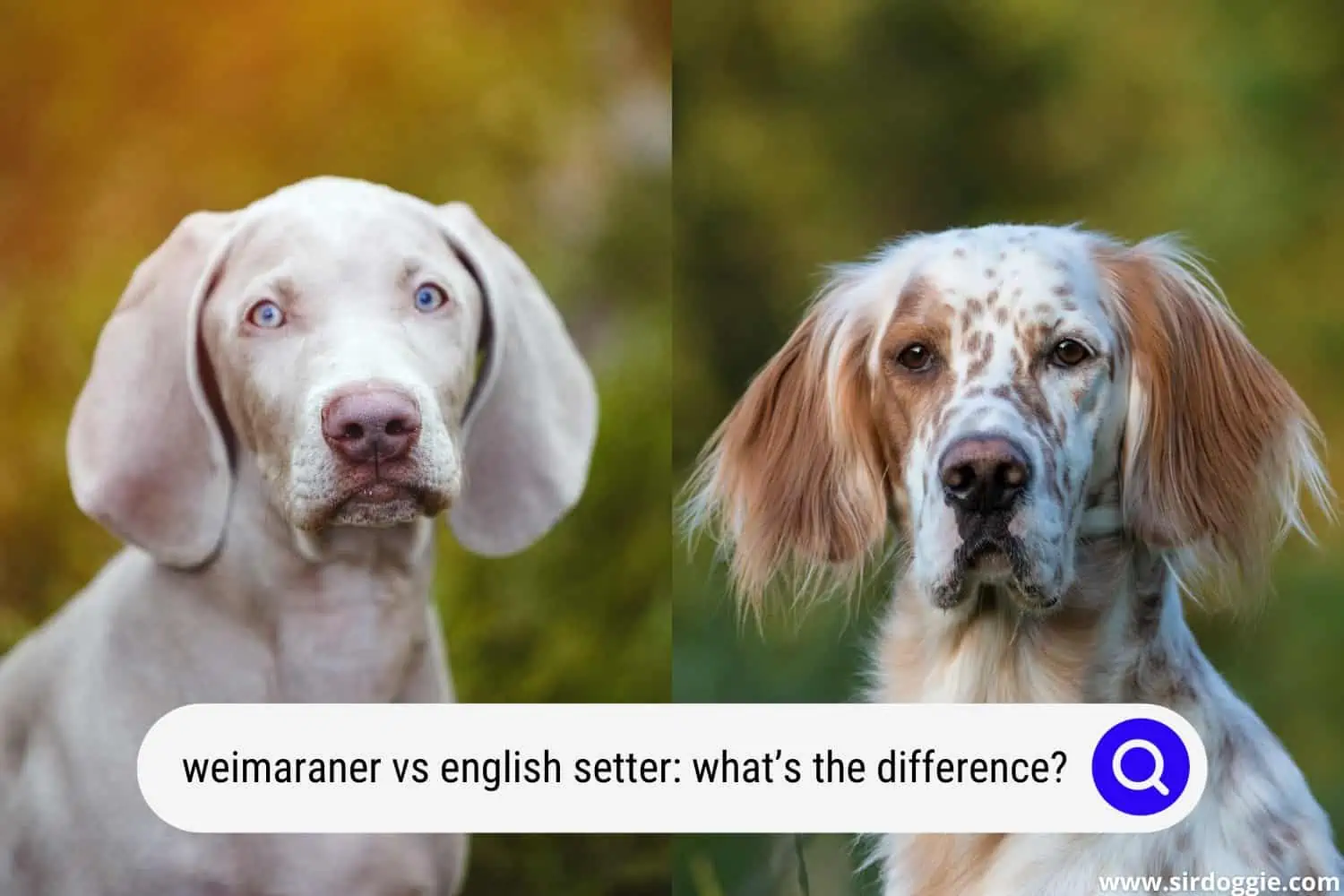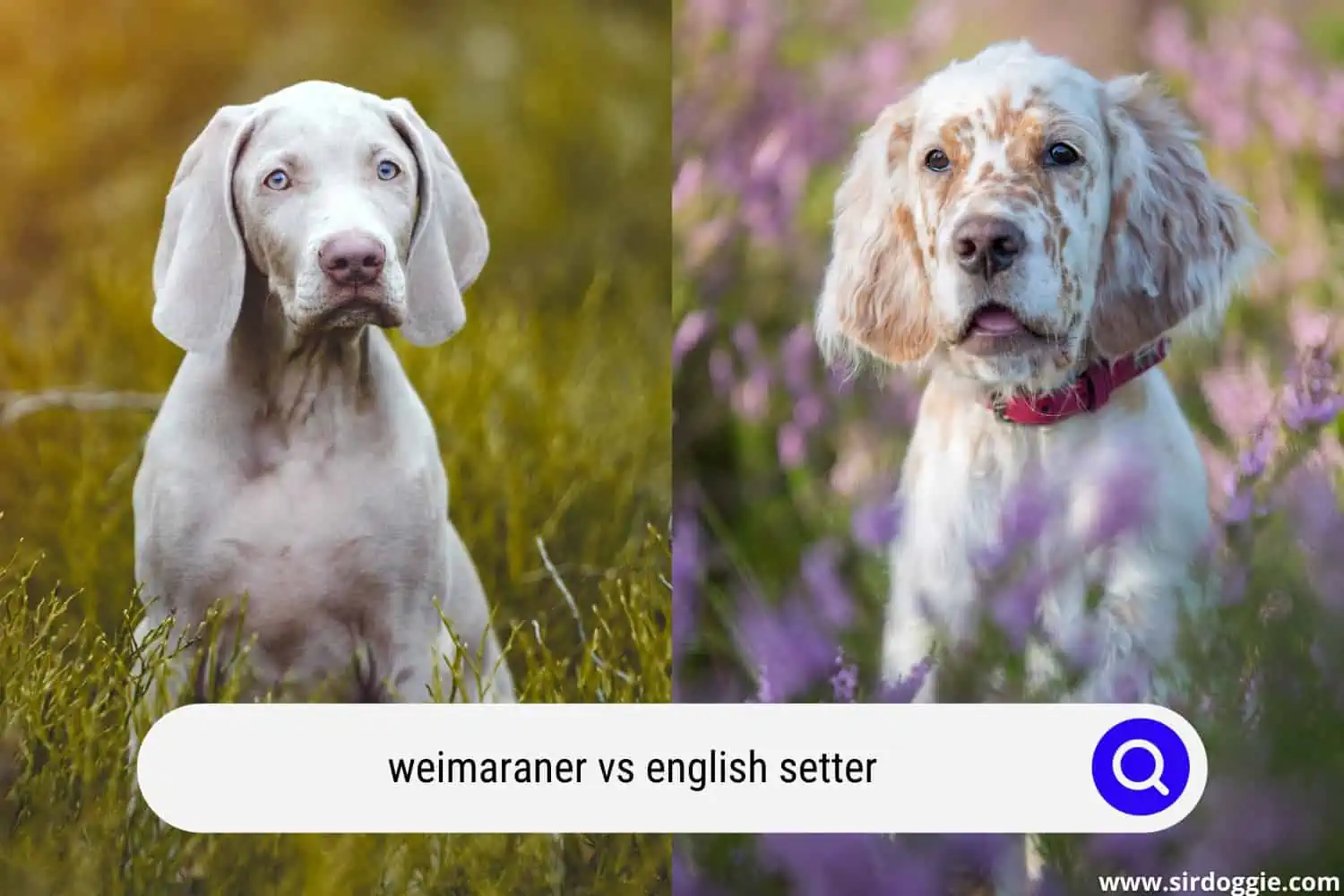Weimaraner vs English Setter: What’s the Difference?
Weimaraners are active working dogs that are willing to work. In return, those who meet their needs receive a loyal and cuddly companion for life.
Meanwhile, the English setters are beautiful and irresistibly charming. Nevertheless, English setters can prove to be outright stubborn. And her passion for hunting should not be underestimated.
In this Weimaraner vs English Setter comparison article, we’ll find out everything about the English Setter and the Weimaraner dog breeds, while comparing them both side by side.

The Weimaraner
Weimaraners are extremely popular pedigree dogs among dog lovers. Here you will find the most important information about the Weimaraner.
Origin of the Weimaraner
The history of the Weimaraner pointing dog goes back to the time of Grand Duke Carl August von Sachsen-Weimar-Eisenach. He was a friend of Goethe and, as was customary in aristocratic circles in the 18th and 19th centuries.
He was also very enthusiastic about hunting. Weimaraners were kept at his court, and they were probably bred out of dogs that came from France and Bohemia.
At that time, dogs were needed that could cover all areas of the hunt and that also showed manpower.
The Weimaraner was the forester’s typical dog. Not only a highly valued helper in the area but also a kind of life insurance for the forester, because the Weimaraner protected him from poachers and kept his home, often remote in the forest, from uninvited visitors.
Weimaraner pure breeding began around 1890 mainly in Thuringia, and in 1897 a standard was drawn up when the first breed club was founded.
The appearance of the Weimaraner
The Weimaraner is one of the medium to large dogs. Males reach a shoulder height of 59 to 70 cm, bitches between 57 and 65 cm. The Weimaraner has a strong and muscular build with a long body and a slim neck. The Weimaraner’s ears are wide and long.
The Weimaraners’ fur is short, thick, and dense with no undercoat. Even long-haired Weimaraners usually have little or no undercoat. Their fur is soft and smooth or slightly wavy. The coat color of this dog breed is silver, deer, or mouse gray. Weimaraner puppies have blue eyes, and later they turn brown.
Character and upbringing of the Weimaraner
The Weimaraner is a very intelligent and alert dog. It is characterized above all by its high urge to move and its strong will to work and hunting sense. These traits are part of the nature of the dog originally bred as a hunting dog.
On the other hand, the Weimaraner is also very affectionate and people-oriented. It likes to play, even with children. If you train the Weimaraner correctly, you will have a loyal and cuddly companion for life who can also relax. You should plan a lot of time for this breed because the Weimaraner does not like to be alone.
For the upbringing of a Weimaraner, a permanent caregiver who has experience in dog training is necessary. The key is a mixture of composure and authority.
If proper training is not given, the dog not only pulls on the leash when walking but ultimately also chases after everything, be it tracking, the neighbor’s cat, or even joggers and cyclists.
When raising a Weimaraner, it is also important to get it used to other dogs at an early age and to socialize it accordingly.
Weimaraners are hunting dogs and have this predisposition, even if they are no longer exclusively bred as such. In the past, Weimaraners were only bred by hunters for hunters. Today, they are also in demand as fashion or family dogs. But this attitude does not do justice to the work-ready and active breed.
Caring for the Weimaraner
It is not enough for Weimarans to walk three times a day at a walking pace through the housing estate. The Weimaraner is suitable for hunters, dog sports enthusiasts, or very active people.
Weimaraners require little maintenance. This applies to both short and long-haired dogs. Because the Weimaraner is a very hardy breed. It is usually not very susceptible to disease. Hip dysplasia (HD) can occur, as can epilepsy. Allergies can also occur.
The English Setter
English setters are extremely popular pedigree dogs among dog lovers. Here you will find the most important information about the English Setter.
Origin of the English Setter
English Setters are an ancient breed of dog. They go back to the Spanish pointers and long-haired Spaniels. English Setters were popular on large estates in Great Britain as early as the 17th century.
A special breed for different areas of use only followed later. The typical color name of the English Setter “Belton” goes back to a village of the same name in Northumberland.
Appearance of the English Setter
English Setters typically have a long and strong neck and deep-set chest. The body is only moderately long in relation to the height at the withers. The English Setter’s hindquarters are strong. The tail is usually carried in line with the back.
Full utilization is only appropriate when the setter is fully grown. The long-legged, rectangular-shaped dogs should climb as few stairs as possible during the first few months.
Once all growth joints have been closed, many setters remain resilient and agile into old age. With up to 15 years of age – as a relatively large dog breed – they are comparatively long-lived. The long ears require regular inspection and cleaning.
English Setter’s coat and colors
Grooming the English Setter is relatively time-consuming. Regular use is required to enable the dogs, which come in the colors Blue-Belton, Orange-Belton, Liver-Belton, Lemon-Belton, and Tricolor, to look well-groomed.
The long feathering on the forelegs, the trousers on the hind legs, and the longer hair on the chest and underside of the stomach bring plenty of twigs, leaves, and burdock into the house.
The sometimes lush paws of the all-terrain English Setter leave large traces of mud in bad weather if the hair between the paw pads is not cut regularly.
The back fur of the English Setter is trimmed every 6 – 8 weeks so that the elegant body contour is better accentuated. Shearing is not an option because it destroys the breed-typical coat texture.
Character and training of the English setter
English Setters are hard to beat when it comes to gentleness, friendliness, and tolerance. No matter how turbulent everyday family life gets, the elegant Brits are never angry.
They also prove to be devotedly tolerant when dealing with children. They are compatible with other dogs and prefer to avoid an argument. Although that depends on appropriate socialization and upbringing.
It is important to find a way that is understandable and respectable for the smart four-legged friend. Too much pressure is met with incomprehension by the sensitive setter and quickly leads to introverted, fearful behavior.
Inconsistency, on the other hand, fuels characteristics of the doggedly headstrong dog, which are also undesirable in coexistence. English setters like to make their own decisions. They tend to only listen when it suits them and go their way without hesitation. This makes clear rules all the more important, right from the start.
Caring for the English setter
If the breed is geared more towards family and show dogs, a setter does not have to hunt to lead a contented life. But it still needs a lot of exercise, variety, and close family ties.
Setters not only enjoy running, but they also bond very closely with their caregivers. Remaining alone is by no means to the taste of a setter. And those who do not train it from an early age should be prepared for all-pervasive lamentations.
Together with its people, the setter is enthusiastic about many things. It proves its endurance as a riding companion dog. The outstanding nose performance is great when tracking. It is a happy companion when jogging or cycling. Its gentleness and friendly nature predestine it as therapy or visiting dogs in schools.
Weimaraner vs English Setter: a side-by-side comparison
| Weimaraner | English Setter | |
| Size | medium to large | Male up to 69 cm, bitch up to 61 cm |
| Weight | 30-40 kg in adult males 25-35 kg in adult bitches | up to 36 kg |
| Coat length | short or long-haired | medium-length coat |
| Coat colors | silver, deer, or mouse gray | Blue Belton, Chestnut Belton, Lemon Belton, Orange Belton, Liver Belton |
| Country of origin | Germany | Great Britain |

Final Verdict
Above all, previous experience in dog ownership is important for owning a Weim. Also, the urge to move around and be busy with this breed must be met.
This is the only way to ensure species-appropriate husbandry. The Weimaraner is not a classic family dog so it’s not suitable for persons looking for a home companion, a couch potato dog.
Also, depending on whether the English Setter comes from a hunting performance breed or from a breed that is more focused on exhibition qualities, its passion as a hunter cannot be hidden. If you do not have any hunting ambitions, you should not choose a setter from a performance breed.

Family Dog Expert Author
Hi there! I’m Stuart, a devoted dog lover and family dog expert with over a decade of experience working with our furry companions. My passion for dogs drives me to share my knowledge and expertise, helping families build strong, loving bonds with their four-legged friends. When I’m not writing for SirDoggie, you’ll find me hiking, playing with my beautiful dog, or studying music.